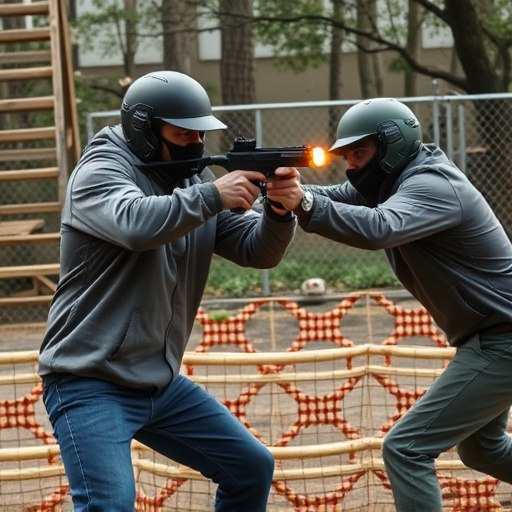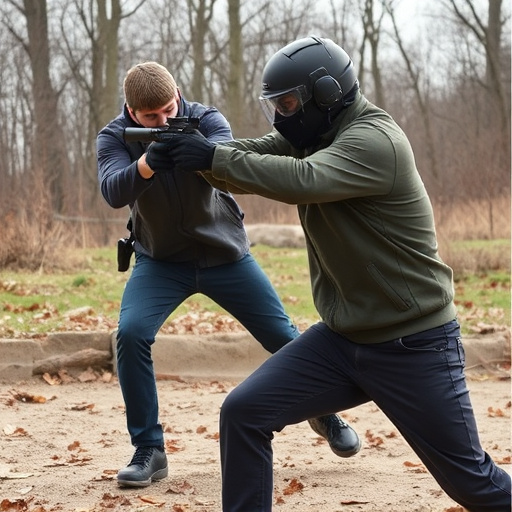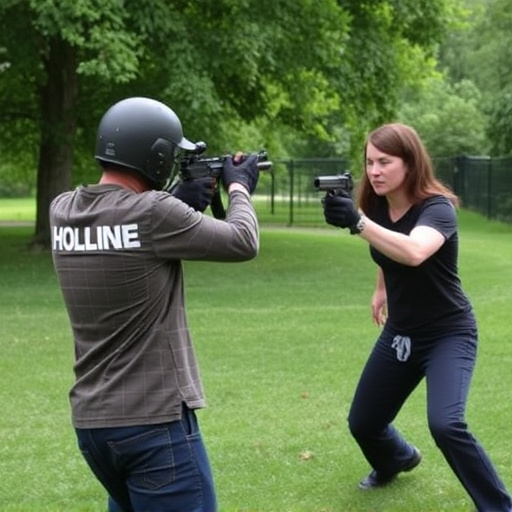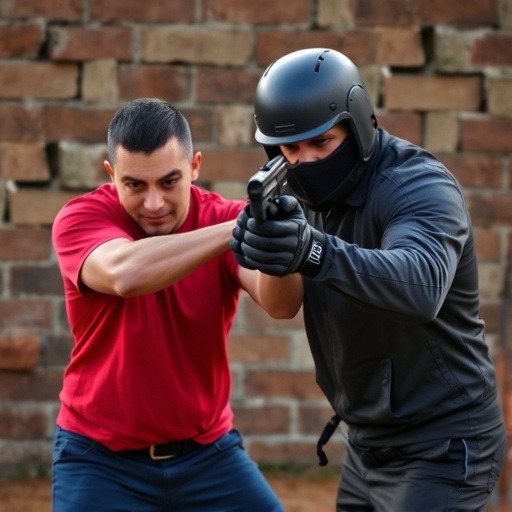Stun guns operate on electrical principles, using high-voltage, low-current pulses to temporarily paralyze targets via muscle spasms. Safe use requires understanding voltage, current, and timing balance, proper target zones, and training. Key components include electrode assembly, power source, and trigger, with manufacturers incorporating safety mechanisms and robust circuit designs. Effective deployment involves correct grip, activation methods, and maintaining safe distances, avoiding metal objects and water to minimize risks while maximizing impact. Regular cleaning, battery checks, and inspections ensure optimal performance and longevity, aligning with responsible stun gun use practices.
Electrical current flow is the lifeblood of stun devices, enabling their powerful defense capabilities. To understand how these instruments work and ensure safe usage, it’s crucial to grasp fundamental electrical principles. This article guides you through the intricate components of a stun gun, exploring how they collaborate to facilitate current flow. We delve into the critical roles of voltage and resistance, while highlighting essential safety measures to prevent overheating and shock risks. Additionally, factors influencing effective range and maintenance tips ensure optimal performance and responsible use of stun guns.
- Understanding Basic Electrical Principles in Stun Devices
- Components of a Stun Gun: How They Contribute to Current Flow
- The Role of Voltage and Resistance in Stun Device Functionality
- Safety Measures: Protecting Users from Overheating and Shock Risks
- Effective Range and Distance: Factors Affecting Current Intensity
- Maintenance and Care: Ensuring Optimal Performance and Safety
Understanding Basic Electrical Principles in Stun Devices

Understanding Basic Electrical Principles in Stun Devices
Stun devices, including stun guns, operate on fundamental electrical principles. At their core, they utilize a high-voltage, low-current electrical pulse to incapacitate a target temporarily. This pulse is generated by a battery and passed through electrodes, which deliver the shock. The key to their effectiveness lies in balancing voltage, current, and timing—a delicate equilibrium designed to disrupt muscle control without causing serious harm.
When you trigger a stun device, a circuit is completed, allowing an electric current to flow from the device through the target’s body and back to the ground. This process generates a powerful jolt that can cause muscular spasms, disorientation, and temporary paralysis. Proper use requires understanding how this flow of electricity works, ensuring safety for both the user and the targeted individual, especially in emergency situations where How to Safely Use Stun Guns techniques become paramount.
Components of a Stun Gun: How They Contribute to Current Flow

Stun guns, also known as electroshock weapons, are designed to disrupt an attacker’s motor functions through a powerful electrical discharge. Understanding their internal components is key to comprehending how they enable safe and effective self-defense. A stun gun typically consists of several essential parts: an electrode assembly, a high-voltage power source, and a trigger mechanism.
The electrode assembly, usually located at the end of the device that makes contact with an attacker, conducts the electrical current. These electrodes are designed to provide a large surface area for maximum current flow, ensuring a strong shock. The high-voltage power source, often a battery or a charged capacitor, stores and releases the necessary energy to generate the electrical pulse. Upon activating the trigger mechanism—typically a button or switch—the circuit is completed, allowing the stored energy to flow through the electrodes and deliver a powerful shock to the target. This intricate design contributes to the device’s ability to incapacitate an assailant safely, with minimal risk of permanent harm. When using a stun gun, it’s crucial to follow safety guidelines, such as aiming for specific body zones and ensuring proper training, to maximize its effectiveness while minimizing potential side effects.
The Role of Voltage and Resistance in Stun Device Functionality

The functionality of stun devices, particularly stun guns, hinges on the intricate interplay between voltage and resistance. When a user activates a stun gun, an electrical current flows through the device, delivering a powerful shock to the target. Voltage, measured in volts, represents the force behind this current. A higher voltage translates to a more intense shock, effective for subduing an attacker quickly. However, it’s crucial to balance voltage with resistance, which is the opposition to the flow of electricity. Stun guns are designed to manage this resistance, ensuring that the electrical current flows efficiently to the target while minimizing harm to the user. Understanding how voltage and resistance interact is key to safely using stun guns—a critical aspect for personal safety and responsible ownership.
Safe usage involves recognizing that excessive voltage can lead to prolonged or repeated shocks, posing potential health risks. Conversely, insufficient voltage may not deliver a powerful enough jolt to incapacitate an assailant effectively. Users should familiarize themselves with the device’s specifications, including its voltage rating and resistance level, to ensure safe and responsible deployment. By comprehending these technical aspects, individuals can make informed decisions when considering how to safely use stun guns as personal defense tools.
Safety Measures: Protecting Users from Overheating and Shock Risks

Using stun devices, such as stun guns, comes with inherent risks if proper safety measures aren’t in place. Overheating and electrical shocks are two primary concerns that users should be aware of. Manufacturers often integrate several features to mitigate these risks, including high-quality insulation and robust circuit designs. How to safely use stun guns involves understanding these safety mechanisms and adhering to the guidelines provided by the manufacturer.
Regular maintenance, such as cleaning and inspecting the device for any signs of damage or wear, is crucial. Additionally, users should be educated on the correct usage techniques, including proper grip and activation methods. Avoiding metal objects and water proximity can further reduce shock risks. By combining these safety measures with responsible use, individuals can maximize the effectiveness of their stun devices while minimizing potential hazards.
Effective Range and Distance: Factors Affecting Current Intensity

The effectiveness of a stun device, or stun gun, is greatly influenced by the current intensity delivered to the target. The range at which a stun gun can safely and effectively disable an attacker is crucial for users to understand when learning how to safely use stun guns. Several factors play into this critical aspect.
Distance, among other variables, significantly impacts current strength. As the distance between the user and the target increases, so does the spread of electrical current, leading to a decrease in intensity. This is why close-range engagements are typically more effective. Proper training emphasizes maintaining a safe distance to ensure the stun gun’s current delivers maximum impact while minimizing harm to bystanders or the user themselves.
Maintenance and Care: Ensuring Optimal Performance and Safety

Proper maintenance and care are essential for keeping stun devices in optimal working condition and ensuring safety during use. Regular cleaning and inspection are crucial steps to follow. Stun guns, like any other electrical device, can accumulate dust and debris, especially if used frequently in outdoor or harsh environments. Use a soft cloth to wipe down the exterior, paying special attention to the trigger mechanism and contact points. Avoid using water or abrasive cleaners that could damage the device.
Additionally, check the battery regularly, ensuring it is charged and functioning correctly. Most stun guns use replaceable batteries, so keep spare batteries on hand. Inspect the device for any signs of wear, corrosion, or damage, replacing any broken parts promptly. Proper care not only enhances performance but also extends the lifespan of your stun gun, making it a reliable tool when you need it most. Remember, how to safely use stun guns includes maintaining them responsibly to safeguard yourself and others.
Understanding the electrical current flow within stun devices is paramount for safe usage. By grasping basic principles, component functions, and safety protocols, users can ensure these powerful tools serve their intended purpose while minimizing risks. Regular maintenance and awareness of factors affecting current intensity further enhance performance and user protection, making informed operation a key aspect of how to safely use stun guns.
